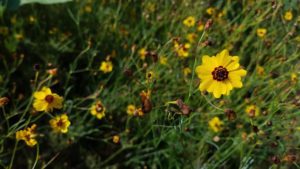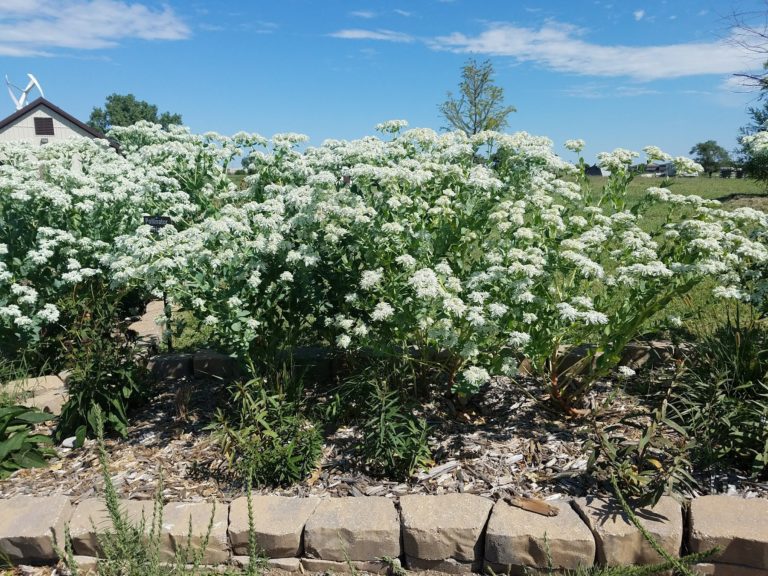Native Gardening
Native gardens are great way to help out our local ecosystems and make a true difference for pollinators, bugs, and more.
Main Notes and Takeaways
- There are many reason to try native gardening, and it’s important to find your Why (more below).
- All gardens need upkeep, and native gardens are no exception. Whether to leave seed heads, chop back plants, or how much weeding you do will come back to your Why (more below).
- General tips:
- Group plants with similar water needs together
- If you want to plant for pollinators, make sure to have flowers blooming year round!
- Remember: prairie plants take time. Year three is when they fully shine.

On February 7th, 2023 Wichita became the first Bee City USA affiliate in the state of Kansas. Bee City Wichita strives for more pollinator gardens and habitat across the city as well as more pollinator-friendly pest management practices.
Our Favorite Notes from This Episode
Find Your Why to Plant Native
Everyone’s reason for making the switch to native plants will be different, and that’s okay! Here are just a few of the benefits to native plants:
- Use less water. It’s xeriscaping without cactus and rocks!
- Beauty/aesthetic value. Native plants come in a wide range of colors and shapes and make for a very unique garden.
- Planting for wildlife. You can tailor your garden to benefit birds, bugs, mammals, or any other wildlife you may be interested in attracting.
Let’s expand upon the third point: planting for wildlife. Native gardening is particularly important for pollinators and insects. Without their specific host plants they can’t raise their young. The most famous example is monarch needing milkweed, but this delicate relationship exists across insects with some needing one specific species in order to reproduce.
Even if you don’t like bugs that much, when you plant for bugs you end up helping the whole environment around you. Birds need caterpillars to feed their young. If you have a vegetable garden all the pollinators attracted to your native plants will visit your other plants and help give you a bigger harvest.


Something else to keep in mind: native gardens can be an exercise in experimentation! In the wild Snow on the Mountain grows in a single stalk with a small bundle of flowers on top. In a manicured garden without much competition they can turn quite bushy! This may not be a look everyone loves, but the pollinators sure loved it.
Native Gardening Upkeep
How you take care of your garden will depend on your Why for native gardening. If you want a pretty garden, you might need some extra weeding time and prune back plants more frequently. If you’re planting for pollinators it’s a good idea to leave the leaves and leave seed heads and standing vegetation over winter. These sources of shelter are where our native bees, moths, and other pollinators will take refuge to escape the cold.
The “Chelsey Chop” is a great method or upkeep that, no matter your Why, is good to know. Pruning back up to half of a growing plant can help keep it at a manageable height as well as increase flowering. You want to do any chopping before Summer sets in, so in North America that is going to be late May for the end of chopping season. Note: once your plant starts putting on flower buds it is too late. It’s hard to make flowers, and very stressful to have them chopped off.
Let’s talk everyone’s least favorite garden task: weeding. While a deep mulch layer will help keep weeds at bay, every garden needs some editing. And here’s a secret: it’s okay to edit out native plants that pop up where you don’t want them. Keep your garden looking in a way that makes you happy and you’ll want to spend more time in it. Bonus: the more time you spend in your garden the more you’ll realize how much good you’re doing for the environment as you see bugs and birds exploring. Try to pay attention to plants as they grow so you know what counts as a “weed” in your garden and needs removed.
Sources/Further Reading:
- Bee City Wichita – local resources for native plants and native plant recommendations (coming soon)
- Dyck Arboretum of the Plains “Prairie Notes” blog – native prairie planting tips and tricks
- Lady Bird Johnson Wildflower Center – database of US plants
- GrowNative.org – database with lower Midwest focus
- FloraVeg.eu – Europe native plant/habitat database
Did you spot an error or have questions about this post? Email Nicole Brown.
